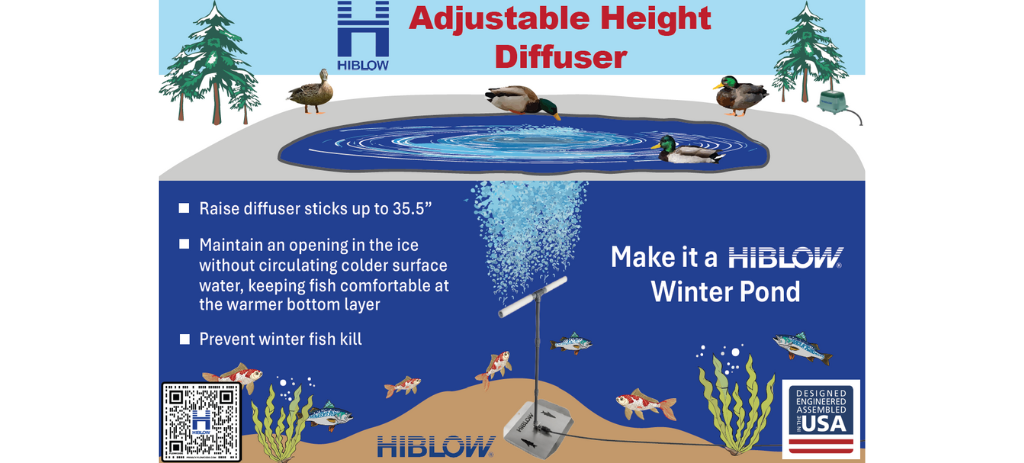Want to DIY your own pond?
Looking for the right type of diffuser and other equipment?
We've got the info you need in our complete DIY pond aeration guide.
Choosing the Installation Location
If you are installing a solar system, then your aerator will likely be located right next to the pond.
If you are utilizing AC electricity, then there are a couple of options:
Running electrical power to the water’s edge: We have heard of many folks hiring electricians and running power to the water; however, it can be very expensive considering the labor involved and the wire gauge needed to run long distances.
The most common (and recommended) location is near your electrical power source. It is typically more cost effective to run tubing from your power source to the water’s edge – even hundreds of feet.
Choosing the best HIBLOW model:
Reference your notes on the size and depth of your pond and check out our article regarding choosing the best model and size air pump for your application. https://www.hiblow-usa.com/2021/04/12/what-size-air-pump-should-i-use-to-aerate-my-pond/
Tubing Type and Size:
If you are planning on installing the aerator at the electrical source, it is most cost effective to buy PVC pipe, reinforced poly, or irrigation tubing and run that to the edge of the water. If burying the tubing, make sure it can handle the weight of the earth or it may pinch which will reduce or eliminate air flow and put excess pressure on the pump causing it to fail prematurely.
Choosing the right diameter tubing is essential. Generally, the longer the pipe distance, the larger the diameter of the tubing needs to be to reduce friction loss and limit back pressure. Also, the more air flow (bigger the pump), the larger the diameter of the tubing needs to be.
Once to the water’s edge, weighted line is most often used, but not required. Some folks choose to save money by running rigid PVC or flexible poly into the pond. Of course, this requires bricks or cement blocks to weigh it down.
For detailed information on selecting the best tubing for your pond, please check out the following article: https://www.hiblow-usa.com/2020/06/16/what-size-and-type-of-tubing-should-i-use-with-my-pond-air-pump/
Diffuser Quantity and Type:
The diffuser sits at the bottom of the pond and produces microbubbles that rise to the surface. HIBLOW typically suggests a medium bubble diffuser that produces sufficient air bubbles for oxygen transfer but also enough power to mix the pond.
Medium bubble diffusers put minimal backpressure on the air pump and “self-clean”. However, fine bubble diffusers are sometimes the best choice if you have a shallow pond or are trying to grow certain breeds of fish.
The quantity of diffusers depends on your pond size and shape. For instance, if you have a round pond that is 1/8th of an acre, you may need only 1 diffuser to turnover the pond. If you have a kidney shape ½ acre pond, you may need 3 diffusers. Most systems utilize at least 2 diffusers.
For help selecting the best type of diffuser for your pond, check out the following article: https://www.hiblow-usa.com/2021/05/03/pond-aeration-system-diffuser-options/
We Can Help with DIY Pond Aeration!
Overwhelmed by the options and process for DIY pond aeration? We’re happy to help. If you have any questions during the process, please do not hesitate to reach out to us. Happy DIYing!









No comments:
Post a Comment